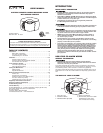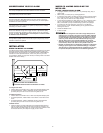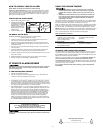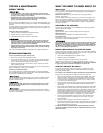
4
WHAT YOU NEED TO KNOW ABOUT CO
WHAT IS CO?
CO is an invisible, odorless, tasteless gas produced when fossil fuels do not
burn completely, or are exposed to heat (usually fire). Electrical appliances
typically do not produce CO.
These fuels include: Wood, coal, charcoal, oil, natural gas, gasoline,
kerosene, and propane.
Common appliances are often sources of CO. If they are not properly main-
tained, are improperly ventilated, or malfunction, CO levels can rise quickly.
CO is a real danger now that homes are more energy efficient. “Air-tight”
homes with added insulation, sealed windows, and other weatherproofing
can “trap” CO inside.
SYMPTOMS OF CO POISONING
These symptoms are related to CO POISONING and should be discussed
with ALL household members.
Mild Exposure:
Slight headache, nausea, vomiting, fatigue (“flu-like” symptoms).
Medium Exposure:
Throbbing headache, drowsiness, confusion, fast heart rate.
Extreme Exposure:
Convulsions, unconsciousness, heart and lung failure. Exposure to carbon
monoxide can cause brain damage, death.
Some individuals are more sensitive to CO than others, including people
with cardiac or respiratory problems, infants, unborn babies, pregnant
mothers, or elderly people can be more quickly and severely affected by
CO. Members of sensitive populations should consult their doctors for
advice on taking additional pr
ecautions.
FINDING THE SOURCE OF CO AFTER AN ALARM
Carbon monoxide is an odorless, invisible gas, which often makes it difficult
to locate the source of CO after an alarm. These are a few of the factors that
can make it difficult to locate sources of CO:
• House well ventilated before the investigator arrives.
• Problem caused by “backdrafting.”
• Transient CO problem caused by special circumstances.
Because CO may dissipate by the time an investigator arrives, it may be
difficult to locate the source of CO. BRK Brands, Inc. shall not be obligated
to pay for any carbon monoxide investigation or service call.
HOW CAN I PROTECT MY FAMILY?
A CO Alarm is an excellent means of protection. It monitors the air and
sounds a loud alarm before carbon monoxide levels become threatening
for average, healthy adults.
A CO Alarm is not a substitute for proper maintenance of home appliances.
To help prevent CO problems and reduce the risk of CO poisoning:
• Clean chimneys and flues yearly. Keep them free of debris, leaves, and
nests for proper air flow. Also, have a professional check for rust and
corrosion, cracks, or separations. These conditions can prevent proper
air movement and cause backdrafting. Never “cap” or cover a chimney
in any way that would block air flow.
• Test and maintain all fuel-burning equipment annually. Many local gas or
oil companies and HVAC companies offer appliance inspections for a
nominal fee.
• Make regular visual inspections of all fuel-burning appliances. Check appli-
ances for excessive rust and scaling. Also check the flame on the burner
and pilot lights. The flame should be blue. A yellow flame means fuel is not
being burned completely and CO may be present. Keep the blower door
on the furnace closed. Use vents or fans when they are available on all
fuel-burning appliances. Make sure appliances are vented to the outside.
Do not grill or barbecue indoors, or in garages or on screen porches.
• Check for exhaust backflow from CO sources. Check the draft hood
on an operating furnace for a backdraft. Look for cracks on furnace
heat exchangers.
• Check the house or garage on the other side of shared wall.
• Keep windows and doors open slightly. If you suspect that CO is escaping
into your home, open a window or a door. Opening windows and doors
can significantly decrease CO levels.
In addition, familiarize yourself with all enclosed materials. Read this
manual in its entirety, and make sure you understand what to do if your
CO Alarm sounds.
TESTING & MAINTENANCE
WEEKLY TESTING
• Test the CO Alarm once a week. If the CO Alarm ever fails to test
correctly, have it replaced immediately! If the CO Alarm is not working
properly, it cannot alert you to a problem.
• DO NOT stand close to the Alarm when the horn is sounding.
Exposure at close range may be harmful to your hearing. When
testing, step away when horn starts sounding.
Push and hold the Test/Silence button on the cover until the LED flashes. The
alarm hor
n will sound 4 beeps, a pause, then 4 beeps. The ALARM (RED) light
will flash.
The alarm sequence should last 5-6 seconds. If it does not alarm, make sur
e
fresh batteries are correctly installed, and test it again. If the unit still does not
alarm, replace it immediately.
If the alarm does not test properly:
1. Make sure that fresh batteries are installed correctly.
2. Be sure the Alarm is clean and dust-free.
3. Install fresh AA batteries* and test the Alarm again.
• DO NOT try fixing the Alarm yourself – this will void your warranty!
If the CO Alarm is still not operating properly, and it is still under
warranty, please see "How to Obtain Warranty Service" in the Limited
W
arranty. Install a new CO Alarm immediately.
• The Test/Silence button is the only proper way to test the CO Alarm.
NEVER use vehicle exhaust! Exhaust may cause permanent damage
and voids your warranty.
*For a list of acceptable replacement batteries, see “Regular Maintenance.”
REGULAR MAINTENANCE
To keep the CO Alarm in good working order:
• Test it every week using the Test/Silence button.
• Vacuum the CO Alarm cover once a month, using the soft brush attach-
ment. Never use water, cleaners, or solvents, since these may damage
the unit. Test the CO Alarm again after vacuuming.
• Replace the batteries when the CO Alarm “chirps” about every minute
(the low battery warning).
The low battery warning should last for 30 days, but you should replace the
battery immediately to continue your protection.
Choosing a replacement battery:
This CO Alarm requires two standard AA batteries. The following batteries
are acceptable as replacements: Energizer E91. These replacement batteries
are commonly available at local retail stores.
Use only the replacement batteries listed. The unit may not operate properly
with other batteries. Never use rechargeable batteries since they may not
provide a constant charge.
DO NOT spray cleaning chemicals or insect sprays directly on or near
the CO Alarm. DO NOT paint over the CO Alarm. Doing so may cause
permanent damage.
Household cleaners, aerosol chemicals, and other contaminants can affect
the sensor. When using any of these materials near the CO Alarm, make sure
the room is well ventilated.



